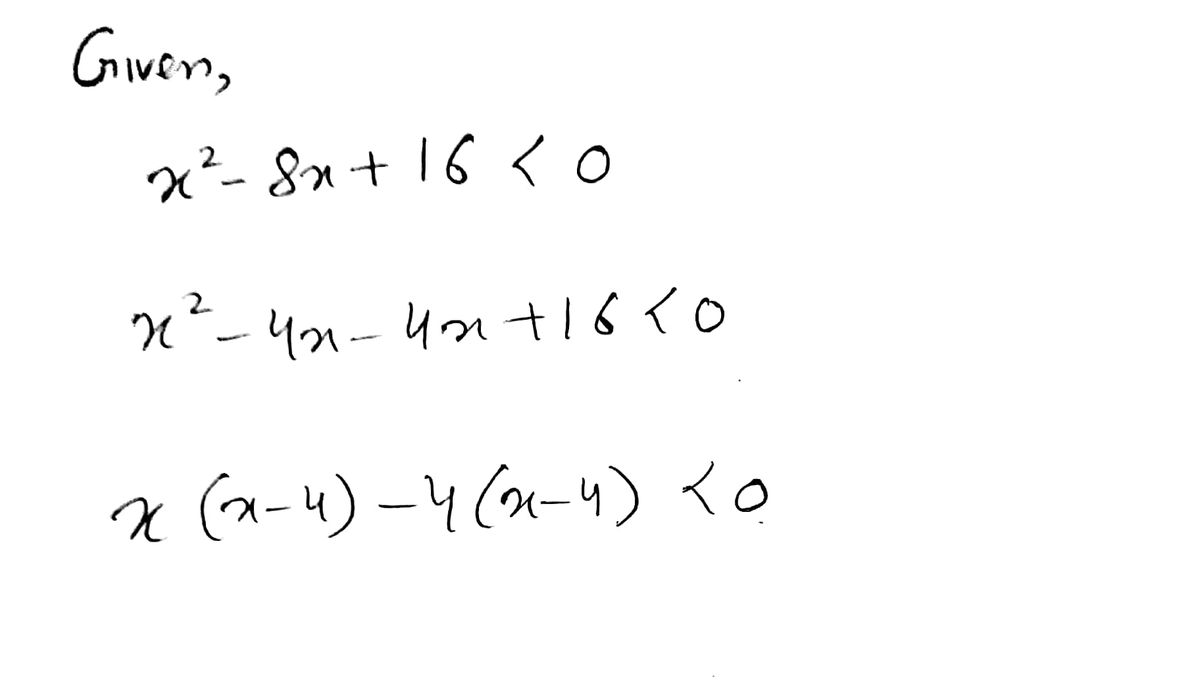**Solve the polynomial inequality and graph the solution set on a real number line. Express the solution set in interval notation.** Given inequality: \(x^2 - 8x + 16 < 0\) **Solve the inequality: What is the solution set? Select the correct choice below and, if necessary, fill in the answer box to complete your choice.** - \( \text{A. The solution set is } \ \underline{\hspace{2em}}. \) *(Simplify your answer. Type your answer in interval notation. Type an exact answer, using radicals as needed. Use integers or fractions for any numbers in the expression.)* - \(\text{B. The solution set is the empty set.}\) **Choose the correct graph below.** - \(\text{O A.}\) Graph line displays a segment from \(-12\) to \(4\), including both endpoints, indicated with a solid blue line. - \(\text{O B.}\) Graph line displays a solid blue arrow extending infinitely to the right from \(4\). - \(\text{O C.}\) Graph line displays a solid blue arrow extending infinitely to the left from \(4\). - \(\text{O D.}\) Graph line displays a solid blue arrow extending infinitely to the right from \(-8\). - \(\text{O E.}\) Graph line displays a segment from \(-12\) to \(0\), including both endpoints, indicated with a solid blue line. - \(\text{O F.}\) Graph line displays a segment from \(4\) to \(12\), including both endpoints, indicated with a solid blue line. **Instructions:** Click to select your answer: - Save for Later The solution to the inequality \(x^2 - 8x + 16 < 0\) results in an empty set since \( (x-4)^2 = 0 \) implies there are no x-values that satisfy the inequality.
**Solve the polynomial inequality and graph the solution set on a real number line. Express the solution set in interval notation.** Given inequality: \(x^2 - 8x + 16 < 0\) **Solve the inequality: What is the solution set? Select the correct choice below and, if necessary, fill in the answer box to complete your choice.** - \( \text{A. The solution set is } \ \underline{\hspace{2em}}. \) *(Simplify your answer. Type your answer in interval notation. Type an exact answer, using radicals as needed. Use integers or fractions for any numbers in the expression.)* - \(\text{B. The solution set is the empty set.}\) **Choose the correct graph below.** - \(\text{O A.}\) Graph line displays a segment from \(-12\) to \(4\), including both endpoints, indicated with a solid blue line. - \(\text{O B.}\) Graph line displays a solid blue arrow extending infinitely to the right from \(4\). - \(\text{O C.}\) Graph line displays a solid blue arrow extending infinitely to the left from \(4\). - \(\text{O D.}\) Graph line displays a solid blue arrow extending infinitely to the right from \(-8\). - \(\text{O E.}\) Graph line displays a segment from \(-12\) to \(0\), including both endpoints, indicated with a solid blue line. - \(\text{O F.}\) Graph line displays a segment from \(4\) to \(12\), including both endpoints, indicated with a solid blue line. **Instructions:** Click to select your answer: - Save for Later The solution to the inequality \(x^2 - 8x + 16 < 0\) results in an empty set since \( (x-4)^2 = 0 \) implies there are no x-values that satisfy the inequality.
Calculus: Early Transcendentals
8th Edition
ISBN:9781285741550
Author:James Stewart
Publisher:James Stewart
Chapter1: Functions And Models
Section: Chapter Questions
Problem 1RCC: (a) What is a function? What are its domain and range? (b) What is the graph of a function? (c) How...
Related questions
Question

Transcribed Image Text:**Solve the polynomial inequality and graph the solution set on a real number line. Express the solution set in interval notation.**
Given inequality: \(x^2 - 8x + 16 < 0\)
**Solve the inequality: What is the solution set? Select the correct choice below and, if necessary, fill in the answer box to complete your choice.**
- \( \text{A. The solution set is } \ \underline{\hspace{2em}}. \)
*(Simplify your answer. Type your answer in interval notation. Type an exact answer, using radicals as needed. Use integers or fractions for any numbers in the expression.)*
- \(\text{B. The solution set is the empty set.}\)
**Choose the correct graph below.**
- \(\text{O A.}\) Graph line displays a segment from \(-12\) to \(4\), including both endpoints, indicated with a solid blue line.
- \(\text{O B.}\) Graph line displays a solid blue arrow extending infinitely to the right from \(4\).
- \(\text{O C.}\) Graph line displays a solid blue arrow extending infinitely to the left from \(4\).
- \(\text{O D.}\) Graph line displays a solid blue arrow extending infinitely to the right from \(-8\).
- \(\text{O E.}\) Graph line displays a segment from \(-12\) to \(0\), including both endpoints, indicated with a solid blue line.
- \(\text{O F.}\) Graph line displays a segment from \(4\) to \(12\), including both endpoints, indicated with a solid blue line.
**Instructions:**
Click to select your answer:
- Save for Later
The solution to the inequality \(x^2 - 8x + 16 < 0\) results in an empty set since \( (x-4)^2 = 0 \) implies there are no x-values that satisfy the inequality.
Expert Solution
Step 1

Step by step
Solved in 2 steps with 2 images

Recommended textbooks for you

Calculus: Early Transcendentals
Calculus
ISBN:
9781285741550
Author:
James Stewart
Publisher:
Cengage Learning

Thomas' Calculus (14th Edition)
Calculus
ISBN:
9780134438986
Author:
Joel R. Hass, Christopher E. Heil, Maurice D. Weir
Publisher:
PEARSON

Calculus: Early Transcendentals (3rd Edition)
Calculus
ISBN:
9780134763644
Author:
William L. Briggs, Lyle Cochran, Bernard Gillett, Eric Schulz
Publisher:
PEARSON

Calculus: Early Transcendentals
Calculus
ISBN:
9781285741550
Author:
James Stewart
Publisher:
Cengage Learning

Thomas' Calculus (14th Edition)
Calculus
ISBN:
9780134438986
Author:
Joel R. Hass, Christopher E. Heil, Maurice D. Weir
Publisher:
PEARSON

Calculus: Early Transcendentals (3rd Edition)
Calculus
ISBN:
9780134763644
Author:
William L. Briggs, Lyle Cochran, Bernard Gillett, Eric Schulz
Publisher:
PEARSON

Calculus: Early Transcendentals
Calculus
ISBN:
9781319050740
Author:
Jon Rogawski, Colin Adams, Robert Franzosa
Publisher:
W. H. Freeman


Calculus: Early Transcendental Functions
Calculus
ISBN:
9781337552516
Author:
Ron Larson, Bruce H. Edwards
Publisher:
Cengage Learning